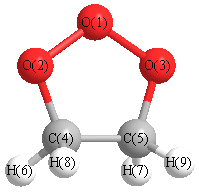Vibrational Frequencies calculated at CCSD/cc-pVTZ
| Mode Number |
Symmetry |
Frequency
(cm-1) |
Scaled Frequency
(cm-1) |
IR Intensities
(km mol-1) |
Raman Act
(Å4/u) |
Dep P |
Dep U |
|---|
| 1 |
A' |
3171 |
2985 |
25.40 |
|
|
|
| 2 |
A' |
3096 |
2914 |
46.20 |
|
|
|
| 3 |
A' |
1544 |
1453 |
0.16 |
|
|
|
| 4 |
A' |
1378 |
1297 |
0.10 |
|
|
|
| 5 |
A' |
1269 |
1194 |
2.27 |
|
|
|
| 6 |
A' |
1063 |
1000 |
35.39 |
|
|
|
| 7 |
A' |
973 |
916 |
12.32 |
|
|
|
| 8 |
A' |
950 |
894 |
3.94 |
|
|
|
| 9 |
A' |
874 |
823 |
0.73 |
|
|
|
| 10 |
A' |
728 |
685 |
1.57 |
|
|
|
| 11 |
A' |
419 |
394 |
3.87 |
|
|
|
| 12 |
A" |
3153 |
2968 |
0.72 |
|
|
|
| 13 |
A" |
3085 |
2903 |
21.75 |
|
|
|
| 14 |
A" |
1526 |
1436 |
0.58 |
|
|
|
| 15 |
A" |
1380 |
1299 |
1.70 |
|
|
|
| 16 |
A" |
1253 |
1180 |
0.01 |
|
|
|
| 17 |
A" |
1179 |
1110 |
0.07 |
|
|
|
| 18 |
A" |
1068 |
1006 |
3.02 |
|
|
|
| 19 |
A" |
828 |
780 |
31.42 |
|
|
|
| 20 |
A" |
748 |
704 |
4.65 |
|
|
|
| 21 |
A" |
122 |
115 |
3.15 |
|
|
|
Unscaled Zero Point Vibrational Energy (zpe) 14903.6 cm
-1
Scaled (by 0.9412) Zero Point Vibrational Energy (zpe) 14027.2 cm
-1
See section
III.C.1 List or set vibrational scaling factors
to change the scale factors used here.
See section
III.C.2
Calculate a vibrational scaling factor for a given set of molecules
to determine the least squares best scaling factor.
